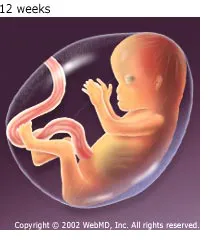Baby: The embryo measures about 0.9 inches to 1.2 inches from crown to rump, or the size of a strawberry. The arms and legs are longer, and the fingers might be a little swollen where the touch pads are forming. The head is more erect and neck is more developed. Your baby now moves its body and limbs, and this movement can be visible during an ultrasound, but you won't be able to feel it yet.
Mom-to-be: Your uterus is continuing to grow, and you may begin to see your waistline thickening. But unless you tell people the good news, your pregnancy still won't be noticeable to others. Weight gain is still small, if at all, since you could be experiencing food aversions, cravings, heartburn, indigestion, nausea and bloating. Mood swings and weepiness similar to PMS symptoms are common, too.

Week 10
Baby: Congratulations! Your baby is now officially called a "fetus." It looks a little like a medium shrimp, measuring 1.25 to 1.68 inches from crown to rump, and weighing a little less than two-tenths of an ounce. You might be reassured to know that most physical malformations, when they occur, have occurred by the end of this week, so the most critical part of your baby's development is safely behind you. But other developmental processes, such as those affecting behavior and intelligence, will continue throughout pregnancy. Eyes are covered by skin that will eventually split to form eyelids.
Mom-to-be: You still probably don't show, but you may be wearing looser clothes. You may even be starting to eye maternity clothes, although you probably still don't need them. You may continue to feel tired and moody, but take heart: These symptoms shouldn't last too much longer.
Tip of the Week: If you're going to have chorionic villus sampling (CVS), a prenatal test used to detect genetic defects such as Tay-Sachs, sickle cell anemia, most types of cystic fibrosis and Down syndrome, it will probably be scheduled between now and 12 weeks.
Week 11
Baby: Your fetus, about the size of a large lime, measures about 1.75 to 2.4 inches from crown to rump and weighs about three-tenths of an ounce. About now the rapid "swooshing" noises of the heartbeat can be heard through a Doppler sound-wave stethoscope. Fingernails and external genitalia are showing distinguishing characteristics, and the baby is swallowing and kicking, although you still won't feel it.
Mom-to-be: Your uterus is almost big enough to fill your pelvis and may be felt in your lower abdomen. You may also experience changes in hair, skin, fingernails or toenails.
Tip of the Week: Don't ignore your dental hygiene during pregnancy. Floss and brush regularly, and make sure you see your dentist at least once in these nine months. Your gums may bleed more because of hormones during pregnancy and because of increased blood volume.
Week 12
Baby: The fetus now measures about 2.5 inches from crown to rump and weighs between three-tenths of an ounce and half an ounce. It is fully formed, from tooth buds to toenails, and your baby's job now is to continue getting larger and stronger for the rest of your pregnancy. With the most critical development behind the fetus, the chance of miscarriage drops considerably after this week.
Mom-to-be: Nausea and energy start to improve. You may be experiencing occasional headaches, dizziness and fatigue from hormonal changes. If it's your first baby, you still could be wearing loose-fitting clothes, but if you've had other pregnancies, you'll probably start to show earlier and may be in maternity clothes. The typical weight gain by now is about three to five pounds. Fathers-to-be might also experience pregnancy symptoms, called couvade or "hatching," during the third month and at delivery, including nausea, abdominal pain, appetite changes and weight gain.
Tip of the Week: Most women develop stretch marks on their abdomen, breasts, hips or buttocks sometime during their pregnancy. They won't go away, but they'll usually fade after pregnancy. Despite claims from manufacturers, creams and oils don't minimize them. It depends on your skin's natural elasticity. Gradual rather than rapid weight gain may help, as well as avoiding excessive weight gain during pregnancy.
What's Happening Inside You?
By the end of the third month, your baby is fully formed. Your baby has arms, hands, fingers, feet and toes and can open and close its fists and mouth. Fingernails and toenails are beginning to develop and the external ears are formed. The beginnings of teeth are forming. Your baby's reproductive organs also develop, but the baby's gender is difficult to distinguish on ultrasound. The circulatory and urinary systems are working and the liver produces bile.

At the end of the third month, your baby is about 4 inches long and weighs about 1 ounce.
Since your baby's most critical development has taken place, your chance of miscarriage drops considerably after three months.
No comments:
Post a Comment